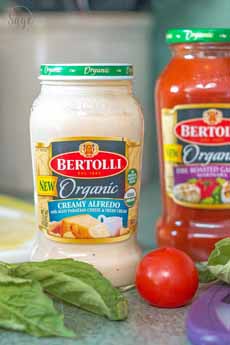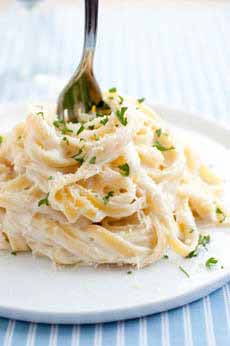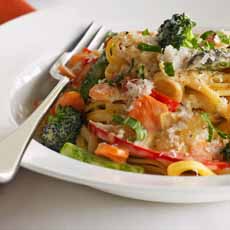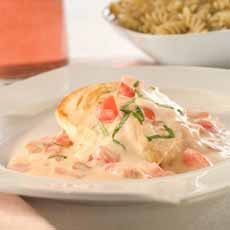PRODUCT: Bertolli Alfredo Sauce For Fettuccine Alfredo Day
|
Just in time for National Alfredo Day, February 7th, Bertolli has introduced two USDA-certified organic alfredo pasta sauces. The creamy new sauces are available in two delicious varieties, including: The plain sauce [photo #1] has a delightful hint of nutmeg, while the garlic sauce is…lightly garlicky. While Bertolli’s sauce is not as rich and artery-clogging as the original recipe (see below), it does need a sprinkle of fresh-grated parmesan cheese to achieve true Alfredo flavor. (TIP: We buy fresh-grated parmesan, romano or pecorino at a specialty market—finely grated, not flakes), and keep the container in the freezer.) While it isn’t part of the original Alfredo recipe, the dish is popularly enhanced with green peas. To tell the truth, the white-on-beige dish needs some color. We also enjoy some shredded fresh basil or chopped parsley [photo #2], plus cracked pepper. You can garnish at will; for example, with diced red bell pepper, and with other herbs or spices. If you like red pepper flakes, for example, sprinkle them on: a hot counterpoint to the creaminess. Americans must love Alfredo sauce. In the conventional (non-organic) line, Bertolli has five options: Alfredo with Aged Parmesan Cheese Sauce, Creamy Basil Alfredo with Aged Parmesan Cheese Sauce, Garlic Alfredo with Aged Parmesan Cheese Sauce, Mushroom Alfredo with Portobello Mushroom Sauce, and Reduced Fat Alfredo Sauce. The organic Alfredo sauces join a lineup of organic red sauces, including Fire-Roasted Garlic Marinara; Five Cheese, Tomato & Basil, and Olive Oil, Basil & Garlic. While the original Chef Alfredo created a rich but plain pasta dish, subsequent cooks have used the sauce in more elaborate ways. For purists, the name in Italian is Fettuccine all’Alfredo. The original recipe was created in 1914 by Alfredo Di Lelio, owner of Alfredo alla Scrofa restaurant in Rome. As the story goes, Alfredo created the dish to appeal to his pregnant wife, who had lost her appetite. He served it with egg fettuccine, hoping that the “nutritious dish*” would do the trick. In his restaurant’s kitchen, the hot fettuccine was tossed in a skillet with the grated parmesan, butter and cream. As the cheese melted into the butter and cream, it formed a sauce that coated the pasta. He finished the dish with grated parmesan. Long before Alfredo created his recipe, Italians enjoyed variations of the dish: fettuccine al burro, fettuccine with butter; and fettuccine al burro e panna, with butter and cream—both served, of course, with grated parmesan. When butter was added both before and after fettuccine was put in the serving bowl for tossing, it was known as doppio burro, double butter. Alfredo tweaked the recipe slightly. He doubled the amount of butter in the bowl before the fettuccine was added, creating a triplo burro, triple butter, recipe. More butter made more of a sauce (and an even richer sauce). Italian White Sauce Cousins Alfredo sauce’s cousin is carbonara sauce, also a white cream sauce made with cream, parmesan, and eggs instead of butter. It is further flavored with onion, garlic and pancetta (streaky bacon is often substituted in the U.S.). |
 [1] Bertolli’s new organic Alfredo sauce (photo courtesy Kim of 730 Sage Street, who used the sauce to make this Creamy Tuscan Chicken recipe).
|
|
|
Rosa sauce is an Alfredo-style cheese sauce tinted pink with tomatoes (rosa means pink). Buon appetito! *Today, we know that a small serving of the “nutritious dish” has 455 calories, 38g of fat, 291mg of sodium and 143g of cholesterol. But for people who love rich, creamy food, it hits the spot |
||





